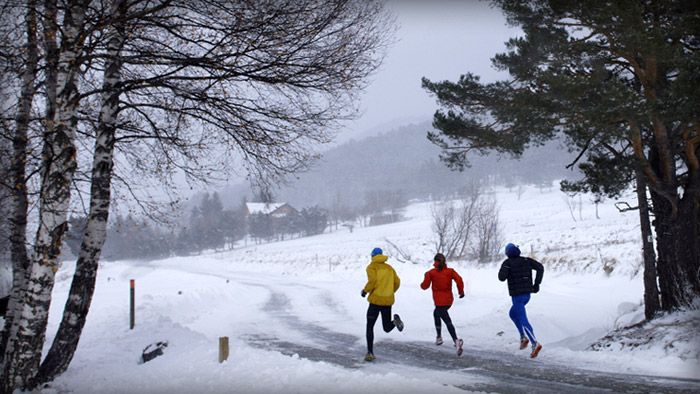In the Northern Hemisphere, we’re entering a time of the year in which the days are getting shorter, the temperatures are slowly creeping down, and the alarm clock seems even harder to listen to. If you’re like me, fighting to get out of bed is a real thing this time of year. That doesn’t mean you don’t care about your goals — you’re just battling the change of the seasons. Here are six things you can do to get out the door for your run and make the experience as pleasant as possible.
6 Tips for Running in the Dark During the Winter
1. Be Savvy About Seasonal Affective Disorder
Seasonal Affective Disorder, or SAD, is your body’s natural response to the changing of the seasons. Reduced levels of sunlight effectively throw off your circadian rhythm and also cause a drop in serotonin and melatonin, leaving you feeling moody and sapped of energy. If you’re feeling like it’s “worse than normal”, you may want to see your primary care physician and discuss a few options.
2. Maximize Your Exposure to Sunlight
A common remedy for seasonal affective disorder is utilizing a light box during the day to help replicate light exposure. Phototherapy is very effective and is commonly used by athletes in northern climates to help regulate serotonin and melatonin levels. It can also be beneficial to move your runs to daybreak or midday to maximize sun exposure during the week — getting as much time as you can outside in the daylight is imperative. If you live in a cloudy climate, you may consider working with a professional to find Vitamin D and other supplements to keep you healthy year-round.
3. Wear Bright Gear While Running in the Dark
There are entire companies committed to your safety when it comes to running in low light, from light vests to waist lamps, to reflective pants and adhesive stripes. These are important to have, especially if you live in a rural area or have to fight traffic on the side of the road. To be seen is to be safe!
4. Find a Running Buddy or Group
When we’re running out of daylight, it’s easy to come up short on motivation. Putting on a headlamp on a cold evening can feel very difficult — maybe even insurmountable. However, if you’re meeting a friend for a morning run or your running group for an evening jaunt, it becomes a whole lot easier to brave the elements. Don’t be afraid to flex your schedule so that your easy runs fall at a more convenient time or day of the week. As a coach, I encourage athletes to still do their workouts independently of the group so that they can stick to their training plan. The simple act of showing up, seeing other people fighting the elements, and enjoying the camaraderie during the warm-up and cool-down is reason enough to show up.
5. Change Up Your Running Routes
When you’re fighting daylight, it can feel like you’re stuck in a rut and may simply need a change in scenery. This could mean exploring a new neighborhood, driving to a different part of town, or just taking a slightly different route from normal. Changing up your route will help you feel more engaged and more aware of your surroundings as you run. To keep in the moment, you may want to seek out well-decorated homes to show your family later, find a new place to eat, or find your own place of solitude on a new trail. New trails and routes can be the slight shift you need to help you get out, explore, and find something unexpected right in your backyard.
6. Treat Yourself to Treadmill Runs
When the snow is drifting, the wind is whipping, and the temperatures are bitterly cold, you don’t have to fight the elements. Running on the treadmill is always an option, albeit one that elicits mixed emotions. A recent study showed that distraction can play a positive role in your running, and that first starts with how you approach your indoor run. If you associate treadmill runs with a difficult task, it will show up that way for you.
I have many athletes who “save” their TV time for when they’re on the treadmill or bike trainer. This way, the treadmill becomes a reward of sorts and an effective time management tool. Maybe running in the winter is the perfect way to catch up on a show everyone is talking about at the office. It might be the perfect time to watch Pam and Jim fall in love on The Office for the 35th time (does it ever get old?). Giving yourself a distraction or even a little indulgence is a great strategy to help you get your runs in when the days are shorter.
Getting your workouts in when it’s dark isn’t easy, but a lot of it boils down to your mindset. If you’re dreading the cold air hitting your face first thing in the morning, you may need to shift your mindset from “this is going to suck” to “I’m stronger for getting out today.” This first requires you to self-reflect and understand why you’re dreading the task at hand — a difficult task for most, but a rewarding one. As the daylight dwindles, take a few moments to strategize how you’ll make this season the one where you got the miles in when it wasn’t easy. I promise that it will pay off in the spring!
References
Aghdaei, M. et al. (2021, October 1). The Effects of an Associative, Dissociative, Internal, and External Focus of Attention on Running Economy. Retrieved from https://journals.humankinetics.com/view/journals/jmld/aop/article-10.1123-jmld.2020-0067/article-10.1123-jmld.2020-0067.xml









